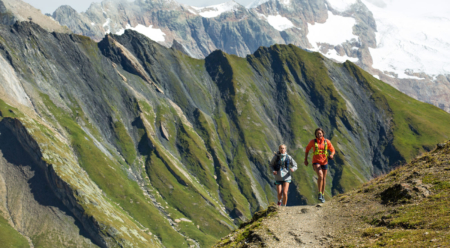The Disaster Training Plan: Running the Tour du Mont Blanc with Jenn Shelton
“We just have to run 20, 30 or 50 miles a day over some mountains. What could go wrong?”
When I received my itinerary from Jenn Shelton to run the Tour du Mont Blanc, I took a hard swallow of quickly drying saliva, knowing that my background as a middle-distance track racer (specializing in the 5K) would not prepare me for the 105-mile Tour du Mont Blanc which passes through three countries (France, Italy and Switzerland) and gains 30,000 feet of elevation in the technical terrain of the Alps. While I lacked the typical preparations needed for a through-trail run of this magnitude—I don’t run 105 miles in a full week let alone four days—my stoke to explore a new mountain range was high, as was my willingness to hop on a plane to Chamonix and prepare myself for the biggest run of my life with just five day’s notice.
Granted, this particular method did not help me or my running compatriots, Jenn and photographer Andrew Burr, actually finish the Tour du Mont Blanc (TMB), but it proved effective enough to help me run farther than I ever thought imaginable in three short days, despite torrential downpours, wrong turns, snowy mountain passes and minor injuries. While it’s no scientific formula or rule book by any means, the Disaster Training Plan will help prepare you (mostly mentally) for maximum adventure and “fun” when you have the urge to take on something way beyond your current fitness, perceived ability or experience level. You don’t have to be a professional athlete or an ultramarathoner to complete an epic multiday trail run—you just have to be crazy enough to say yes and accept the inevitable beat down that will happen to you along the way.
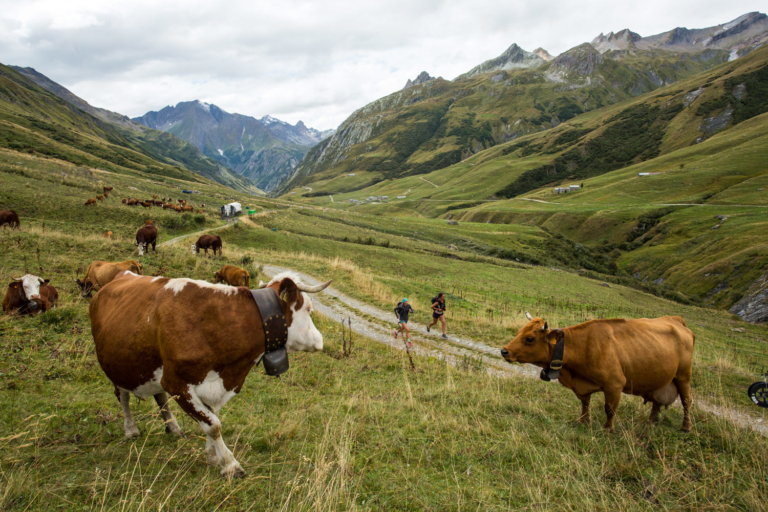
The locals stare in wonder as Morgan Sjogren and Jenn Shelton giggle their way directly into the next storm. Photo: Andrew Burr
Pregame
Every runner knows that with less than a week until your event the only thing left to do is taper (to rest your body), carbo load and hydrate. I took this very seriously in the days before taking on the TMB—with an “easy run” straight up the vertical K in Chamonix “just to get a coffee.” Another option is to just lay in the grass and stare up at Mont Blanc as you study the guidebook. Individual definitions of the chill pill may vary. The result (hopefully): feeling in tip-top condition on the first day, so you have a true baseline of just how hard you will run yourself into the ground.
Pack Light
If you are using the Disaster Training Plan, you are already a glutton for punishment so don’t make it worse by bringing anything unnecessary in your pack that will weigh you down. I carried my trusty M10 Jacket, Houdini Pants, Nano Air Jacket, extra socks, water and lots of snacks. Bottles of rosé are important. Don’t forget those. They quickly help you forget about that next 5,000-foot climb up ahead.
Ready, Set, Hike
On game day, we set a not-so-strict start time of 9 a.m. and took off … at walking pace. This confused the hell out of me because in track I run fast, not slow, and walking is not even in my forward motion vocabulary. However, I learned this strategy will save your legs for the long mountainous stretches of trail in the days to come. Three days later I sang the praises of the stage one “Tour of Sidewalking” as I crawled, exhausted, shivering and with trench foot, up two 5,000-foot Italian mountain passes in a massive rain/sleet/snow storm. I will never scoff at the notion of walking ever again.
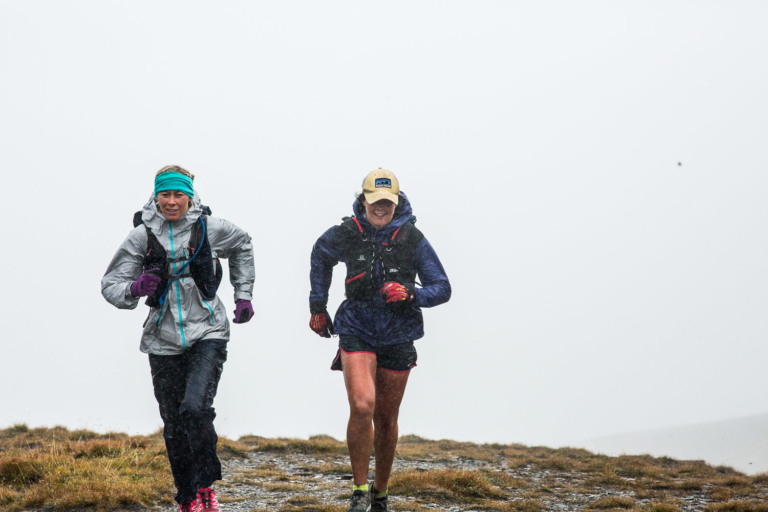
When disaster strikes, just furrow your brow, look it in the face and laugh with the madness of truly living in the moment. Photo: Andrew Burr
Refuel
On long days, make sure you are eating plenty of real foods—things like spaghetti and meatballs, beer (yes, that’s a food group), candy, Nutella and hard-boiled eggs. There is no science behind this. You have two options in the disaster plan: Eat what tastes good or eat what is available. A soggy tuna sandwich can quickly become both when you are lost in Italy with many hours of running ahead of you over yet another mountain pass.
Shake It Out
When you complete a section of a multiday adventure, don’t immediately sit down and start drinking wine. Open the bottle and stretch it out. A bit of active recovery in the form of yoga, light walking, medieval sword fighting or even dancing will help keep your blood circulating and your muscles from cramping up. Remember: You’re not done yet, so don’t act like it.
Read the Maps, Guidebooks and Signs
You’re already going much farther than you have any business going. Don’t screw it up with a wrong turn and make your day exponentially longer. Of course, this is the disaster plan and you likely didn’t even take weather conditions into consideration before you started. All it takes is one heinous storm of slashing rain to leave your map in less-than-useful condition and the signs impossible to find through the mashed potato thick fog. When this happens don’t forget to smile and find other uses for it like toilet paper, tissue or even a rain hat.
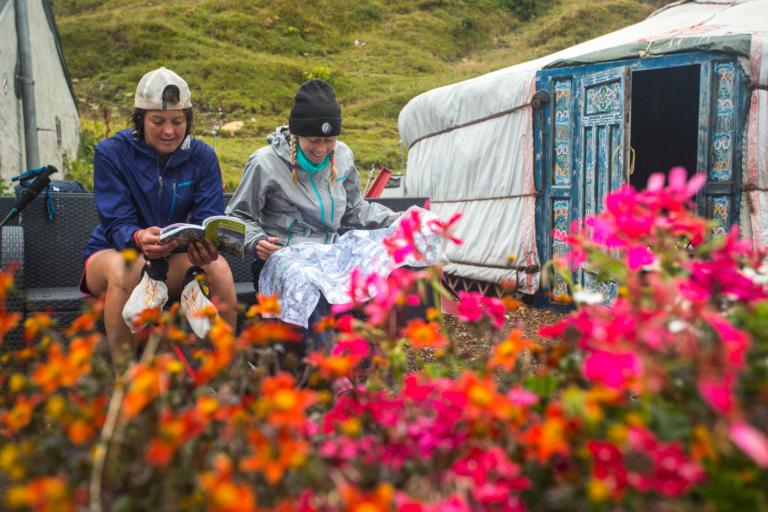
Jenn and Morgan consult useless rain-soaked maps in a quest to find the next refugio. Switzerland. Photo: Andrew Burr
Expect the Unexpected
When the Disaster Training Plan is followed properly, you will have a distinct advantage over your fully trained compatriots: no preconceived expectations. Even the most skilled, talented and prepared adventurers will face challenges and major obstacles, but a bold soul like you expects this and therefore is much more resilient in the face of adversity. It’s what you signed up for. When disaster strikes you will furrow your brow, look it in the face and laugh with the madness of truly living in the moment.
Heart Trumps Training
The mental training required to complete a big mountain mission can’t be overlooked. Andrew—a climber who admittedly did not run more than six miles (ever) before the TMB—is likely an alien or has magic powers, but he swears that he is able to keep pace with professional runners (all while carrying heavy camera equipment) because of his mental game, “If you love adventure, you have to be able to turn your brain off and enjoy the suffering part of the process.” So yeah, it’s going to hurt. Deal with it.
Accept Failure and Enjoy the Journey
Some rad dude (Yvon Chouinard) once said, “It’s not an adventure until something goes wrong.” Disciples of the Disaster Training Plan are seeking just that. You didn’t jump on this trail to get a finishers medal or set a Strava record. This is a transformative experience. One that will break you down to nothing more than your underwear (because your clothes are permanently soaked) as you eat yet another plate of pasta at an Italian refugio while the rain beats down upon the tin roof. You will wonder how you will take one more step, but you go on anyways because you have no choice—the nearest train station is an entire country away over, yes, another mountain pass. However, the Disaster Training Plan does not discourage making the bail-out option your new goal. Sitting through a marathon travel day of hitchhiking, plus multiple trains and buses, in your rain- and cow-shit-soaked clothing is a right of passage all its own.
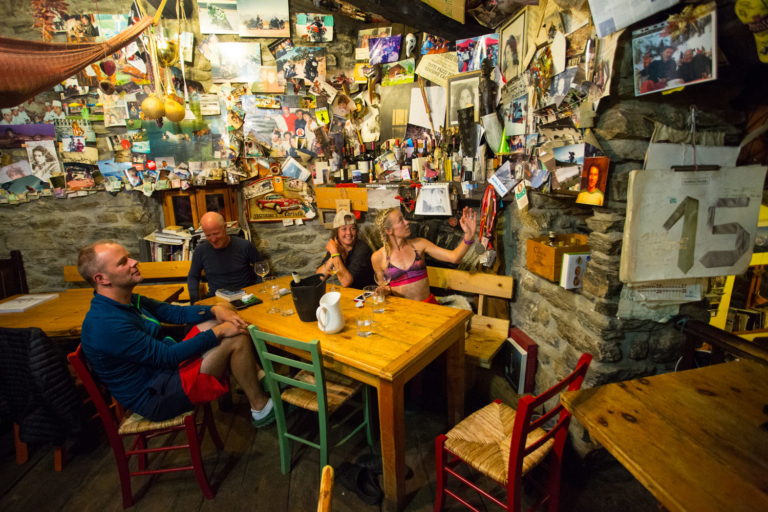
Rain-soaked gear? No problem! Morgan dines in her underwear and demonstrates one of the benefits of the Disaster Training Plan: always having a great bar story. Photo: Andrew Burr
Be Willing to Recover
Don’t expect to walk away from this game plan in one piece. Afterwards, you will drink whiskey. You will need ibuprofen. You will buy cheap frozen peas to reduce the swelling. Your ass will be laid up on the couch. You will elevate your swollen limbs. But you will accept and ingest all of this with a twisted smile on your face basking in the glow of proving the naysayers (most likely your own body parts) wrong.
While the Disaster Training Plan may not leave you fully ready for the heinous slog you are about to begin, it will save you from the worst type of agony possible: the regret of not even trying. At the very least you will always have a cool bar story, and maybe a few battle wounds, but more than likely you will uncover a piece of yourself that can only be found deep in the wilderness while traveling under the power of your own motor along the edge of a path unknown.
